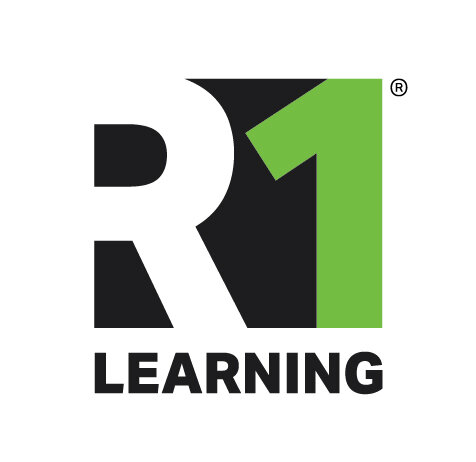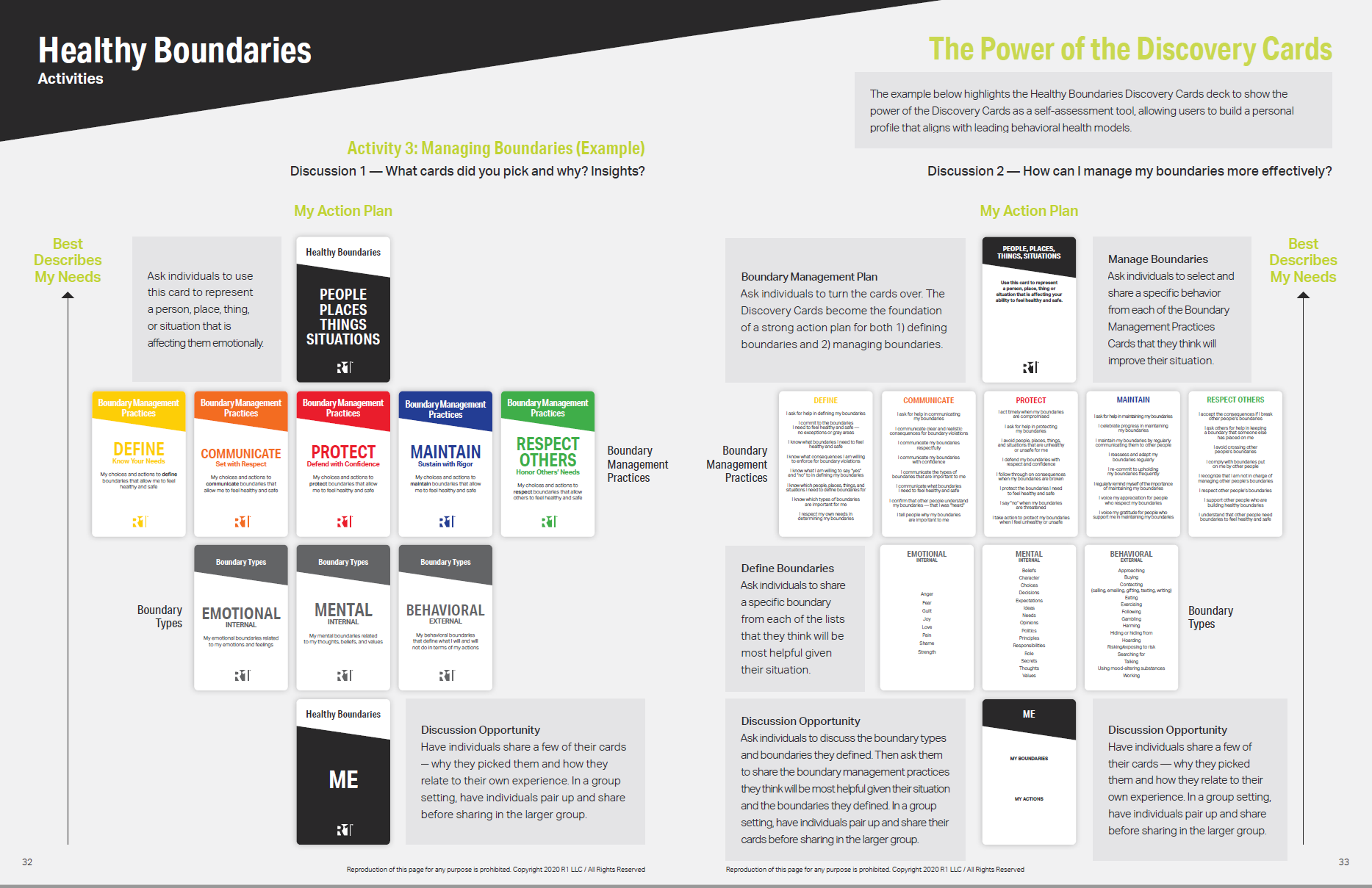5 Boundary Management Practices — Do I Know the Fundamentals for Building Healthy Boundaries?
Healthy Boundaries is one of the best practice topics in the R1 Learning System and the focus of today’s post. As R1 continues to extend our reputation and impact nationally, I continue to find this topic at the top of the list for most programs and practitioners we meet. The struggles of boundary management touch all individuals in the world, not just individuals dealing with substance use or other mental health conditions. It is a universal challenge and one worth building on from our post back in July of 2019, 8 Boundary Types for Building Healthy Relationships – Which Ones Are Most Difficult for You? As I mentioned then, boundaries have been a significant struggle for me and one of the reasons for R1’s existence in the first place. The discussions we spark in our Train-the-Trainer and Practitioner Training programs are worth noting as these conversations are not only illuminating for individuals attending the training, but equally engaging and impactful when delivering in groups or one-on-one settings following the training. The conversations are rich and insightful because of the simplicity of our two models for boundaries: 8 Boundary Types and 5 Boundary Management Practices. Today’s post provides you with simple boundary management models that you can teach others so they can improve their abilities to observe, evaluate, and practice boundary management in their lives. Our goal is to provide you with a simple, concrete, and memorable model that enables individuals to self-discover insights about their behavior. And through this process, build their skills for change and make healthy choices to be and feel healthy and safe.
5 Boundary Management Practices - What Are Your Strengths and Gaps?
Boundaries are central to being and feeling healthy and safe in the world around us. Boundaries are also at the core of building and maintaining healthy and meaningful relationships. It is important to recognize that when we use the word, relationships, in this context, they are broader than just people. In this context, relationships refer to our environment — basically the world around us, including all of the people, places, things, and situations in our lives. These environments include things like our living space or home, food, body, and the Internet, and places like schools, workplaces, and community spaces. Even what happens in the conscious or unconscious realm of our minds — including thoughts, feelings, and beliefs — is part of this environment.
People often speak vaguely about boundaries. Like in any other subject, we first need to learn the fundamentals for defining and managing boundaries. The words we choose — our vocabulary — are so important for individuals when practicing healthy boundary management. Without a broad and specific set of vocabulary, it can be difficult to observe and express what one is thinking and feeling and make better choices as a result.
Healthy Boundaries — Explore R1 Discover
How can understanding healthy boundaries models help? Defining what boundaries are important for us to feel healthy and safe is the first step. Learning how to manage those boundaries once they are defined allows individuals to practice behaviors that strengthen our ability to build and maintain boundaries over time. The Healthy Boundaries topic in the R1 Learning System is organized around two models: 1) 8 boundary types and 2) 5 boundary management practices.
8 Boundary Types — The Boundary Types Model defines eight types of boundaries in two categories: external and internal. External boundary types are external to one’s mind — outside of one’s thoughts, feelings, and beliefs. These include behavioral, material, physical, sexual, and social boundaries. Internal boundary types are internal to one’s mind — inside one’s thoughts, feelings, and beliefs. These include emotional, mental, and spiritual boundaries. Learning these distinctions enables individuals to know what is important for them to feel healthy and safe in the different areas of their lives. Please refer back to our earlier post for more details on boundary types, 8 Boundary Types for Building Healthy Relationships – Which Ones Are Most Difficult for You?
5 Boundary Management Practices — The Boundary Management Practices Model defines five practices: define, communicate, protect, maintain, and respect others’ boundaries. For each practice, the Discovery Cards identify healthy behaviors that will help strengthen boundaries through their frequent, repeated, and consistent use. Understanding one’s frequency, strengths, and gaps in applying these practices enables individuals to improve their behavior over time, leading to better choices and actions for building healthy and safe relationships in the world around them.
Defining 5 Boundary Management Practices
Healthy Boundaries
Definition: A boundary is the line or edge that marks the limits of something
Purpose: To be and feel healthy and safe
The twenty (20) bulleted behaviors below are a subset of the forty (40) listed in the R1 Discovery Cards deck and Facilitator Guide. Use the list below to think about your own boundary management strengths or gaps or someone you are working with and then answer the Questions to Explore below.
DEFINE — Know Your Needs: My choices and actions to define boundaries that allow me to feel healthy and safe. Discovery Cards examples include:
I know which types of boundaries are important for me
I know what I am willing to say "yes" and "no" to in defining my boundaries
I know which people, places, things, and situations I need to define boundaries for
I know what consequences I am willing to enforce for boundary violations
COMMUNICATE — Set with Respect: My choices and actions to communicate boundaries that allow me to feel healthy and safe. Discovery Cards examples include:
I communicate my boundaries with confidence
I communicate the types of boundaries that are important to me
I confirm that other people understand my boundaries — that I was "heard"
I tell people why my boundaries are important to me
PROTECT — Defend with Confidence: My choices and actions to protect boundaries that allow me to feel healthy and safe. Discovery Cards examples include:
I avoid people, places, things, and situations that are unhealthy or unsafe for me
I defend my boundaries with respect and confidence
I follow through on consequences when my boundaries are broken
I say "no" when my boundaries are threatened
MAINTAIN — Sustain with Rigor: My choices and actions to maintain boundaries that allow me to feel healthy and safe. Discovery Cards examples include:
I celebrate progress in maintaining my boundaries
I reassess and adapt my boundaries regularly
I regularly remind myself of the importance of maintaining my boundaries
I voice my appreciation for people who respect my boundaries
RESPECT OTHERS — Honor Others’ Needs: My choices and actions to respect boundaries that allow others to feel healthy and safe. Discovery Cards examples include:
I avoid crossing other people's boundaries
I accept the consequences if I break other people's boundaries
I understand that other people need boundaries to feel healthy and safe
I recognize that I am not in charge of managing other people's boundaries
Questions to Explore
Answer these questions for yourself or someone you are working with.
Did you find the Boundary Management Practices helpful in thinking about your boundaries?
Did the 5 Boundary Management Practices help you to better pinpoint specific strengths or gaps? How were these categories helpful?
Which Boundary Management Practices were most prominent as you thought about your own boundaries? Does this make sense to you?
As you look back over your relevant relationships history, which practices did you manage frequently or well? Which areas were gaps?
Think about a specific situation you are dealing with today… which practices are you managing frequently or well? Which areas need more attention and effort?
What is one action you can take today that would improve your relationship and make both you and /or the other person feel more healthy and safe?
Who can you ask for help and support in managing your boundaries?
References
Cloud, Henry. Townsend, John. Boundaries. Grand Rapids, MI, Zondervan, 2002
Freundlich, Lawrence. Mellody, Pia. The Intimacy Factor. New York, New York. Harper Collins Publisher, 2004.
Mellody, Pia. Miller, Andrea Wells. Miller, J. Keith. Facing Codependence. New York, New York. Harper Collins Publisher, 2003.
Whitfield, Charles. Boundaries and Relationships. Deerfield Beach, FL, Health Communications, Inc. 2010.
Copyright 2023 R1 Publishing LLC / All Rights Reserved. Use of this article for any purpose is prohibited without permission.
R1 Train-the-Trainer — Build Your Organization’s Capability
Two-day Program (virtual or in-person)
Enable your organization to train internal practitioners and staff on how to implement the R1 Learning System effectively .
The R1 Learning System provides an engaging, interactive, and personalized approach for training practitioners and engaging individuals in service. The R1 Train-the-Trainer program will provide the training, tools, and resources to engage different populations and settings and practitioners at all levels of knowledge, skill, and experience.
Engage, Educate, and Equip Your Practitioners
Healthy Boundaries Resources
The R1 Learning System and the Discovery Cards Group Kits enable programs to implement workforce training programs strategically. Contact us to learn more about how to best implement the R1Healthy Boundaries in your program, train your team, and engage clients in service. Visit the R1 Store to learn more about our training, tools, and technology resources. The Discovery Cards are an amazing tool for exploring these topics with individuals or groups.
Here are a few ideas to help you learn more about R1 and engage others on this topic:
Share this blog post with others. (Thank you!)
Start a conversation with your team. Bring this information to your next team meeting or share it with your supervisor. Change starts in conversations. Good luck! Let us know how it goes.
Visit www.R1LEARNING.com to learn more about R1, the Discovery Cards, and how we’re creating engaging learning experiences through self-discovery.















